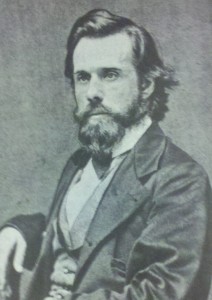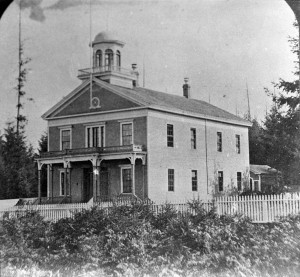Oh, the places you’ll go! (Part 2)
Note: this article is part two of a multi-part series on the Origins and the Historic Locations of the Washington Territorial Library. If you have not read part one, please click here to access the article.
Circa 11/1854: B.F. Kendall’s Building*

In November of 1854, the library was relocated to a small wood-frame building on Fourth and Main Street. Territorial Librarian B.F. Kendall had the structure built specifically to hold the library materials, the law insisting that it be housed “as convenient as possible to the house occupied by the legislative assembly.” [1854 Laws, pg. 415.]
“The legislators, holding a proprietary attitude toward the library, bridled at Kendall’s action; they fully expected the Territorial Library to be located under the same roof as themselves…” explains former State Librarian, Maryan Reynolds, in her history of the State Library, The Dynamics of Change.
In truth, the legislature had not had a building built specific to its needs up to this point. It met for its first session starting on February 27th, 1854, at the Gold Bar Restaurant on Second and Main in downtown Olympia [Newell History, pg.36] and then moved during the time of the Indian uprising to the Olympia Masonic Temple on Eighth and Main, meeting there from 1855 to 1856. [Stevenson, pg. 146.] The building was still unfinished at the outbreak of the Indian Wars.
This demand for clarity over the location of the library stands to emphasize the collection’s value as a tool of both the government and its people. We are not sure as to when this building stopped being used as the library, but we place it at 1856, when a hastily constructed territorial Capitol Building was completed. The image we have of the two story structure is apparently not representative of the building as it stood from the late 1856-1863. The cupola, veranda and overall finished look of the site were added in 1875 (W. T. Jackson, PNQ, 36:3 pg. 262)
At some point Kendall’s original Fourth and Main building was demolished and replaced with the McKenny Building (built in 1889), which also acted as a home for the collection, from 1891 to 1901.
*No picture of the B.F. Kendall building available. If you have an image or leads towards an image of this historic site, please contact us at [email protected]
1856-1875: Territorial Legislative Building*

According to local historian George Blankenship, the library collection was shifted to the Old Territorial Legislative Building upon completion of its construction. [MS 37, “Paper read at the Olympia Public Library, 1932-11-08.”] The building was built in 1856 on 12 acres donated by Edmund Sylvester. The new Legislative Building was described by historian Gordon Newell as a “wooden two-story structure that stood between where the present Legislative and Insurance Commissioner buildings now stand.” The frame building, as described by Acting Governor Charles Mason, measured 40 feet by 68 feet, and two stories high. The first floor held the House of Representatives and two small committee rooms. The second floor held two additional committee rooms, the Council chamber and a room for the Territorial Library.
Again, the library was at the center of controversy – a much larger one than Kendall’s decision to locate it on 4th Avenue. Maryan Reynolds again explains: “A sizable number of legislators sought to move the territorial capital from Olympia to Vancouver. Their first step was to pass a law requiring Territorial Librarian J.C. Head to move his office and the library to Vancouver between June 2 and August 1. Another law mandated a popular vote on the issue during July, which the legislators were certain would favor their cause. But Acting Governor McGill refused to permit the move, and the district court refused to require J.C. Head to show cause as to why he should not move the library.”
The building was hastily built and never really in an ideal state following its occupancy. Reports of the era described it as a “sad picture of melancholy dinginess” [Ex. Doc. 144, 43rd Congress, 2nd Sess.] and according to Ezra L. Smith in his letter entitled, “Estimate of the current expenses of the Legislative Assembly and Secretary’s Office of the Territory of Washington for the fiscal year ending June 30th, 1870” the building was “in a sad state of repair” with worn out furniture; “faded, soiled, and ragged carpets;” and a rotting wooden block foundation that had caused the building to slope toward one end. As described in 1874 by Henry J. Struve, Territory Secretary, the territorial Capitol Building was “left in an entirely unfinished condition” following its construction. He continues: “The walls of the main chambers, committee rooms, library, entrance halls, &c., have never been lathed, plastered, or painted, and a portion of the same were and remain to this day, covered with rough, unplanned boards with a coat of common whitewash.” Alongside this description, Struve requests the Secretary of the Interior approve $5,274.75 toward needed repairs and upgrades to the building, which the Secretary of the Interior affirms in a return correspondence, dated April 2, 1875. The repairs were completed by year’s end.
An interesting side note: Territorial Librarian John Paul Judson, a 24-year-old law student at the time of his appointment, actually lived in the Legislative Building during his year-long tenure. He did this on practical grounds, claiming it was the best way to gain access to the resources he needed to support his education.
*WSL has, to date, no pre-1889 pictures of the Territorial Legislative building. If you have an image or leads towards an image of this historic site during that time, please contact us at [email protected]
Next week: How the library came to share space with another library, and the struggle to move it back to the legislative building.